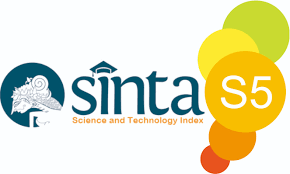Bilingual E-Book: A Platform to Promote Culinary Tourism from Palembang
 Abstract views: 31
,
Abstract views: 31
,
 pdf downloads: 10
pdf downloads: 10
Abstract
The culinary industry is one of the leading sectors in creative industries, with pempek from Palembang being a notable example. The increasing number of national and international events held in Palembang underscores the importance of promotion and marketing. In the era of Society 5.0, the use of digital and English-based promotional media is essential. This study employs research and development methods to describe the design and development of a bilingual e-flip book as a promotional tool for culinary tourism. The product is a digital promotional medium accessible via an Instagram link, featuring an attractively designed digital book with a red, black, and white color scheme. Each page includes images of products, prices, brief descriptions, facilities, ordering procedures, and payment methods in both Indonesian and English. The flip book effect simulates the experience of flipping through a real book. The product validation results from language experts (90) and design experts (88.63) yield an average score of 89.32, indicating high suitability. Public response to the bilingual e-flip book is very positive, with 69.2% agreeing it is highly efficient for obtaining information about products and facilities at culinary tourism destinations, 65.4% finding the information very accurate, and 71.8% considering it highly practical for promotional purposes.
Downloads
References
Amanullah. (2020). Pengembangan Media Pembelajaran Flipbook Digital. Universitas Pendidikan Ganesha Press.
Amstrong, P. K. and G. (2008). Prinsip-Prisip Pemasaran. Erlangga.
Baedowi, M. M., & Lataruva, E. (2012). Analisis Pengaruh Kualitas Produk, Kesesuaian Harga dan Intensitas Promosi terhadap Keputusan Pembelian Konsumen pada Merek Rokok Djarum Super. Diponegoro Journal Of Management, 1(1). https://ejournal3.undip.ac.id/index.php/djom/article/view/805
Pertiwi, N. A., & Zinaida, R. S. (2020). Palembang Harum: Promosi Dan Branding Kuliner Palembang Di Media Sosial. Jurnal Komunikasi Dan Budaya, 01.
Rangkuti, F. (2013). Teknik Membedah Kasus Bisnis Analisis SWOT: Cara. Perhitungan Bobot, Rating, dan OCAI. Erlangga.
Sudirman, F. A., Susilawaty, F. T., & Fuad Adam, A. (2020). Peluang dan Tantangan Pengembangan Industri Kreatif Kuliner dalam Pencapaian SDGs. Jurnal Ilmu Administrasi Dan Sosial, 9(1).
Sugiyono. (2019). Metode Penelitian Kuantitatif Kualitatif dan R&D. Alfabeta.
Suhada, K., Danuri, D., & Putra, F. P. (2017). Aplikasi web promosi kuliner dan rumah makan online. Digital Zone: Jurnal Teknologi Informasi Dan Komunikasi, 8(1). https://doi.org/10.31849/digitalzone.v8i1.618
Tjiptono, F. (2016). Pemasaran Esesi dan Aplikasi. Andi Offset.
Tresnawati, Y., & Prasetyo, K. (2018). Pemetaan Konten Promosi Digital Bisnis Kuliner kika’s Catering di Media Sosial. PRofesi Humas : Jurnal Ilmiah Ilmu Hubungan Masyarakat, 3(1). https://doi.org/10.24198/prh.v3i1.15333
Widani, N. N., & Suktiningsih, W. (2021). Penggunaan Bahasa Ruang Publik pada Masa Pandemi bagi Industri Kuliner Desa Canggu. Basastra, 10(2). https://doi.org/10.24114/bss.v10i2.27542
Widyadhana, R. S., & Anne Ratnasari. (2022). Promosi Produk Kuliner Melalui Instagram. Bandung Conference Series: Communication Management, 2(1). https://doi.org/10.29313/bcscm.v2i1.653
Yudi Hari Rayanto & Sugianti. (2020). Penelitian Pengabangan Model ADDIE dan R&D: Teori dan Praktik. Lembaga Academic & Research Institute.
Copyright (c) 2024 Aisyah Shahab, Genta Ulina Hutagalung, Leni Rohliah, Eka Lutfiyatun, Akhsan Fulki Pasya, Fathur Rohman, Glorio Christmas Stefanus

This work is licensed under a Creative Commons Attribution-ShareAlike 4.0 International License.
Authors who publish with this journal agree to the following terms:
- The author (s) keeps copyright on any article.
- The author grants the journal, right of first publication with the work simultaneously licensed under a Creative Commons Attribution License that allows others to share the work with an acknowledgement of the work’s authorship and initial publication in this journal.
- Authors can enter separate, additional contractual arrangements for the non-exclusive distribution of the journal’s published version of the work (e.g., post it to an institutional repository or publish it in a book), with an acknowledgement of its initial publication in this journal.
- Authors are permitted and encouraged to post their work online (e.g., in institutional repositories or on their website) prior to and during the submission process, as it can lead to productive exchanges, as well as earlier and greater citation of published work.
- We distributed the article, and any associated published material under the Creative Commons Attribution-Share alike 4.0 International License




